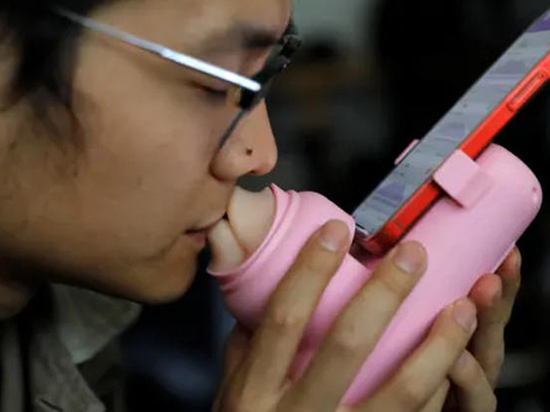The Chinese complained about the device for remote kissing: “Not enough language”
[ad_1]

Chinese startup Siweifushe has invented a remote kissing machine. The gadget picks up and reproduces the sound, and even slightly heats up during interaction with it. The invention caused mixed reactions from Internet users.
MUA – so unpretentious inventor Zhao Jianbo called his creation, which allows you to send kisses from a distance. The gadget transmits data about users’ kisses, collected through motion sensors hidden in silicone lips. When you play the received kisses, the lips simultaneously begin to move.
The gadget was named after the sound that people usually make when they kiss. The device can be called smart as it captures and reproduces the sound and heats up slightly during the kiss. According to Siweifushe, it is these features that make the experience of using the invention more authentic. Happy owners of the gadget can even download kissing data sent by other users through the companion application.
The history of the creation of the device is very touching and was born during the period of self-isolation. Moreover, the Chinese authorities have maintained severe anti-COVID restrictions for the longest time of all other countries. People have been at home for many months, unable to leave their apartments and meet with loved ones. For example, the inventor Zhao Jianbo himself had a relationship at that time, but the young man could not meet his girlfriend.
As a student at the Beijing Film Academy, he focused his graduation project on the lack of physical intimacy during video calls. He later founded Siweifushe, which released its first MUA product on January 22. The cost of the device is 260 yuan (approximately 2900 rubles). Zhao said the firm sold more than 3,000 “kissing machines” in the two weeks after its release and received about 20,000 orders.
MUA resembles a smartphone stand, equipped with colorless pursed lips. To use it to its full potential, lovers must download the app on their smartphones and connect the kissing machines. When they kiss the device, it responds to the kiss.
The gadget is available in several colors. Only the silicone lips themselves are unchanged. Those who had already tried the technological novelty shared a variety of reviews: some users admitted that it was intriguing, while others claimed that they felt uncomfortable.
Among the chief complaints was the lack of language. One internet user described it as a “warm pacifier” feeling. “It’s very uncomfortable, it doesn’t feel like a real kiss,” said a user on the Chinese online shopping platform Taobao.
Others frankly stated that it helped their long-distance relationship: “In the past I could see her, but I can’t touch her, now there is a product that helps us realize a kiss.”
There were some original comments as well. One of the users called the gadget funny, “even if you are alone.” A conservative-minded part of the people expressed concern that the device could be used for online content of erotic content. This area is strictly regulated in China.
Zhao Jianbo commented on such a prospect, saying that his company complies with the rules, but “there is little we can do about how people use the device.”
MUA is not the first virtual kissing device. Researchers at the Tokyo University of Electrical Communications invented the “kiss transfer machine” in 2011, and the Malaysian Imagination Institute created a similar gadget called the “Kissenger” in 2016.
“Kissenger” works in a similar way as MUA, however, the place where a person must put his lips to send a kiss to his interlocutor is a conventional sensor. The Chinese version is more realistic.
In general, inventors have long been trying to make their inventions more realistic. For example, a frightening webcam in the form of a human eye was developed by researchers at Saarland University in Germany. The project was called Eyecam. The camera is made of artificial skin (very human-like), eyebrows, eyelashes, and an eyeball. The webcam can blink, rotate the pupil and repeat the movements of the user. To close the eye, you need to hold your hand in front of it.
The purpose with which such an innovation was created was similar to the idea when creating the MUA. Thus, the developers wanted to create the impression of real human communication during video calls. The inventors had an idea to expand the capabilities of Eyecam, adding, for example, facial expression recognition. Emotions could be transmitted to the interlocutor when people use two such cameras. Apparently, this is exactly what face-to-face communication looks like in the 21st century.
[ad_2]
Source link








